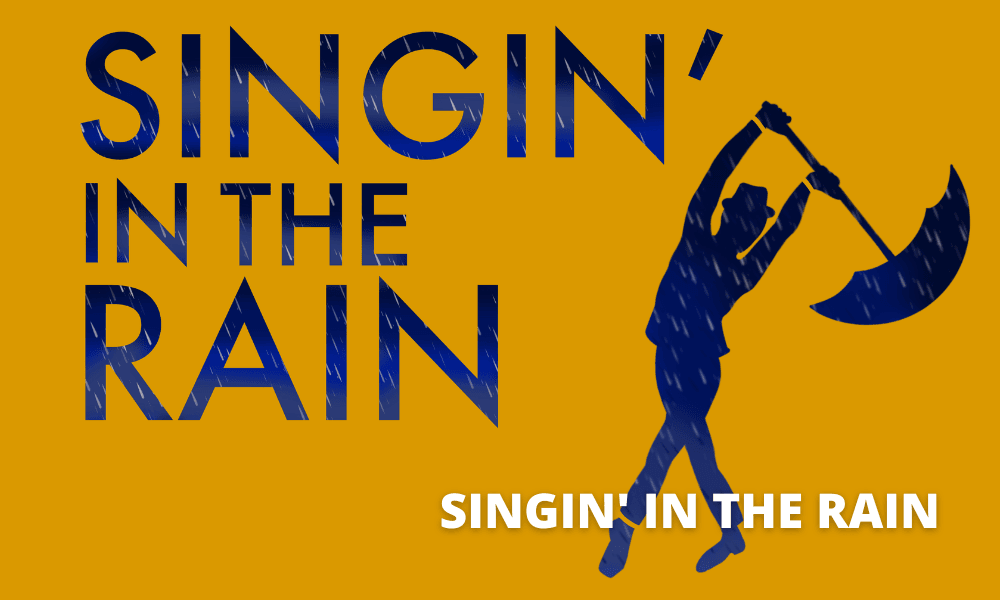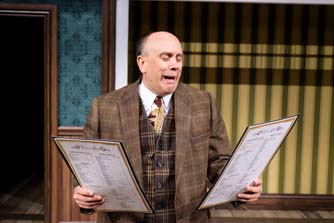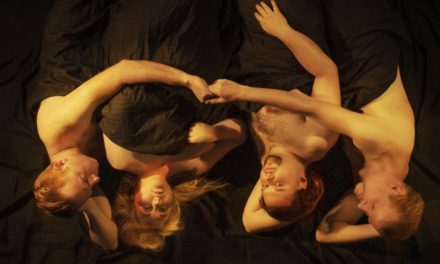DRAPER — Everyone is afraid of something. For Susan DeMill, that fear was facing the towering legacy of an iconic musical like Singin’ In the Rain, written by Betty Comden and Adolph Green with songs by Arthur Freed and Nacio Herb Brown. Singin’ in the Rain is a story that draws on the flapper dresses of Hollywood’s golden age, the transition to “talkies” with a nod to the groundbreaking film The Jazz Singer, and features dance and comedy made famous by Donald O’Conner, Gene Kelly and Jean Hagen. Fortunately, DeMill, along with her cast and crew, were up to the task and put on a dazzling performance that was a ray of sunshine amidst the rain.

Show closes June 10, 2023.
In her director’s note, DeMill discusses the challenges as a dancer and choreographer of, “creating the movement to the most classic and (to me) beloved musical of all time.” The choreography, including the execution of it, however, was the show’s greatest strength. Seamless transitions between spread and unified formations were hallmarks of every ensemble number, and I could not ask for much better extension and grace from local talent. From the leads to the last person cast, dancing was impressive and strong. The female ensemble in “Dream of You” and the men dancing around Lina LaMond (played by Kellie Seiler) in “What’s Wrong With Me?” were both highly polished ensembles that had clearly put in an intense focus on hitting their spots with neat spacing. I felt similarly impressed with the dance solos featured by the characters of Don Lockwood (played by Weston Seiler), Cosmo Brown (played by Tucker Smith) and Kathy Selden (played by Meagan Rudd). Their trio, solo, and work among the ensemble was as enthralling to watch as it must have been exhausting to perform.
The performance, though, had a somewhat plodding start. The cast seemed apprehensive, and at times it seemed like there may have been delays from the sound booth in hitting cues on time. However, the show picked up immensely thanks to two fabulous comedic performances that lifted the energy of the entire cast. Lina LaMond is a tough role to play because an actress has to ride the line between hilariously aloof and detestably grating. The show ends with Lina being humiliated, and the audience has to enjoy that it has happened. But Kellie Seiler got a hole in one. She has completed the best performance of that part I have ever witnessed, including the initial performance by the gifted late Jean Hagen. Kellie Seiler was a riot from her first line. I spent much of the drive home with my wife re-enacting her bits with the microphone as she would “lose” the sound by turning and be flustered by the flowers up on her dress in the first talking picture. Some of those bits were originated by Hagen, but they were reinvigorated by Kellie Seiler, including her hilarious choice to try to nibble vigorously on the flowers when the director was not looking. Kellie Seiler had a doe-eyed intensity that was perfect for the part and even iconic lines like, “Whattya think I am, dumb or somethin’?” were delivered like they were occurring to her for the first time. I would go back again simply to watch her perform, and I am laughing as I write this remembering it.
Similarly, Smith’s portrayal of Cosmo Brown was worthy of the role’s legacy. Brown has to be more than the standard triple threat of singing, acting, and dancing. The actor playing Brown must also play piano, engage in multiple styles of comedy, and not lose that bouncing energy for the entire show. Smith did exactly that. I have shown the original “Make ‘em Laugh” sketch to my middle school students, who sometimes miss the comedy of the bit, as many of those tropes are now so overplayed that the originality of the scene is lost. Smith’s acting and dancing along with some clever staging choices brought the piece to life for a modern audience. At times, he seemed to be overeager, but that infectious playfulness buoyed cast members around him who seemed less certain at times.
The downside to this is that their performances overshadowed the uninspired performances from Rudd as Kathy Seldon and Weston Seiler as Don Lockwood. Weston Seiler, who in real life is married to Kellie Seiler, was a phenomenal dancer and a solid singer. However, his acting felt like he was the lead in a film noir show. He showed muted emotion and little chemistry with those around him. Given the giant personalities of Brown and LaMond, I think Seiler and the ensemble can cut a little more loose at the beginning, as they did by the end of the production. Rudd’s performance as Seldon was strange in a different way. Her singing voice and dancing were both high caliber, and she played the role with great gusto. She just was not a believable Kathy, whose dialogue and given circumstances compel her to be played as grounded, level headed, and subtle. Rudd did not lack for talent; she was bright and engaging who was cast as a stellar dancer. However, Rudd needed to shed the showgirl bursting from the cake and become the romantic lead and LaMond foil as the show evolved. Instead, she often read as Lina LaMond lite.
I commend DeMill and producer Shauna Call for pulling together so many things that make Singin’ in the Rain immensely difficult to produce. The great costuming by Amy Winder matched iconic looks of the Hollywood elites of the 1920s does not come out of thin air. Winder must have had five or six delicate, elegant costumes for every character. The crew produced a show with picturesque sets straight out of the movies and a massive LED projection wall to show the film clips produced in Singin’ in the Rain, such as The Dancing Cavalier. The rain effects that were a mild splash hazard for the first few rows were all part of a production that showed a community that gives generously to the arts and the talent to pull those things together. I particularly enjoyed having scrolling text at the show’s end for the audience to sing along with the number “Singin’ in the Rain” with the entire cast in bright yellow raincoats and clean white umbrellas.
There were a few curious choices that may not have landed as well because of my affinity for the original. For example, I do not know why Don Lockwood left the stage during “Make ‘Em Laugh” when Brown was singing to him. I also was disappointed that the memorable “yes, yes,yes / no, no, no” synchronization was done in a way that the jokes about it lose their humor. The filmed version is supposed to show Lockwood’s voice with LaMond’s acting and then switch. Unfortunately, the version shown in Draper had it technically correct but comically wrong.
The outdoor theatre season is upon us, and I could not be more excited after seeing Singin’ in the Rain. There is something great about seeing shows with members of the community in an outdoor amphitheater. The late start and long winter led to a somewhat colder night, and given that much of the seating is on grassy tiers, bringing camp chairs and blankets is a good plan. But summer doesn’t officially start until you see Draper Arts Council’s Singin’ in the Rain.

These reviews are made possible by a grant from the Salt Lake County Zoo, Arts, and Parks program.




